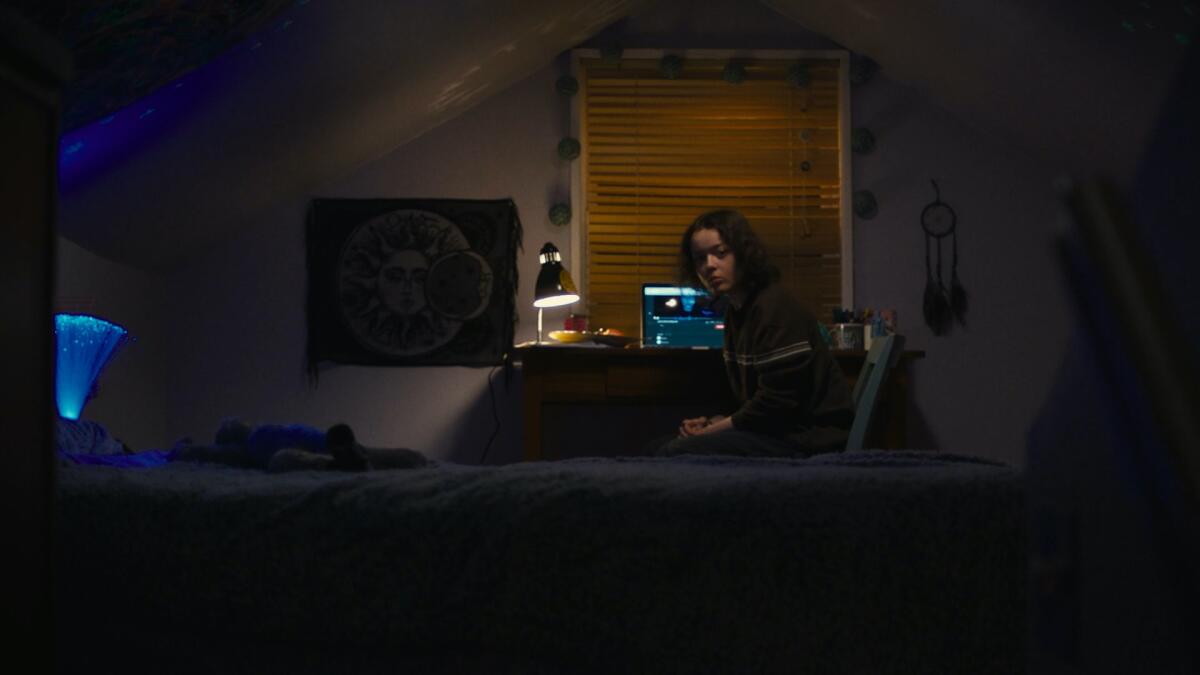Review: ‘We’re All Going to the World’s Fair’ is a brilliant discourse on cyberlife

Entranced by the colorful strobe lights emanating from her computer monitor, Casey (Anna Cobb), a lonely teenager in her attic room, is ready to vanish. She has partaken in the initiation ritual of a seemingly terrifying role-playing game where users — mostly young people — experience bizarre supernatural symptoms.
A brilliantly distinctive portal into the emotional realities we’ve built online, writer-director Jane Schoenbrun’s debut, “We’re All Going to the World’s Fair,” has coded a story endemic to cyberspace and its visual grammar.
For your safety
The Times is committed to reviewing theatrical film releases during the COVID-19 pandemic. Because moviegoing carries risks during this time, we remind readers to follow health and safety guidelines as outlined by the CDC and local health officials.
Paramount to the macabre enjoyment of these immersive urban legends is claiming to believe in the veracity of their virtual otherworldliness. Like those who, by miracle or conviction, speak in tongues in front of a religious congregation to preserve the unspoken pact of a shared sense of comfort, there’s validation in getting scared together. These controlled scenarios of fear offer Casey safety to wrestle with a conflicted, evolving identity.
But when an adult male participant, JLB (Michael J. Rogers) — a potential predator hidden behind a perverse-looking profile picture — recognizes something in her that also consumes him, an invisible bridge emerges across devices. Communicating via messages of artificially created paranormal occurrences on video, they connect. His intentions and concerns only surface later.
Interspersed clips of other players show their investment in outward transformations, playing at growing wings or physically becoming another creature. For Casey, however, the transfiguration is taking place within. As the adolescent performs for the camera, only once does the distant voice of an adult in her real life enter our purview.
That one becomes absorbed in the stakes of these exchanges hinges on young Cobb’s remarkably organic turn of innocence veiled with a see-through facade of fortitude. Schoenbrun repeatedly asserts that Casey is in between states, searching for a conduit to make sense of herself in the intangible presence of those on the other side of the screen.
Aesthetically congruent, “World’s Fair” exists mostly in static screens or hand-held footage from Casey’s POV given raw believability under cinematographer Daniel Patrick Carbone (the director behind “Hide Your Smiling Faces”). Meanwhile, Alex G’s melancholic guitar-centric score hypnotizes by layering unnerving and soothing elements.
Schoenbrun, a native speaker of the language of the internet, has uploaded into the cinematic landscape one of the most thoughtful depictions of self-discovery in the digital age. Through Casey’s plight of suburban isolation, the artist reaches out to us from a corner of the web’s endless abyss with an unmissable invitation, demonstrating the transcendental prowess of storytelling.
‘We’re All Going to the World’s Fair’
Not rated
Running time: 1 hour, 26 minutes
Playing: Starts April 22, Landmark Westwood
More to Read
Only good movies
Get the Indie Focus newsletter, Mark Olsen's weekly guide to the world of cinema.
You may occasionally receive promotional content from the Los Angeles Times.









